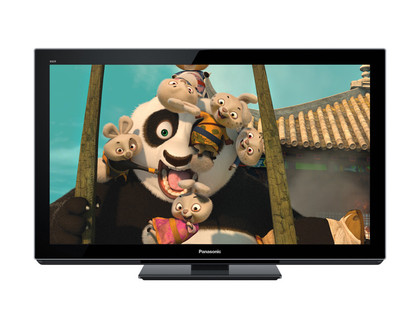Why you can trust TechRadar

The TX-P42VT30B's black level response is the best from any TV since Pioneer's legendary KURO plasmas and there can be no higher praise than that.
The extra contrast filter enables the screen to deliver dark scenes that are richer, more natural and with a greater cinematic punch than those achieved by the GT30 models. Plasma's self-emissive (as opposed to backlit) nature enables the hugely impressive blacks to sit right alongside bright whites and colours with none of the inconsistency that plagues LCD TVs.
Also abundantly apparent is how much richer and brighter colours are on the TX-P42VT30B than they were on last year's VT20 models. This is undoubtedly the result of marked improvements in power efficiency that have enabled brighter pictures without breaking the energy consumption ceilings set by the electronics watchdogs.
Colour tones are extremely natural and have an extra vibrancy that makes it easier to appreciate the finesse with which the TX-P42VT30B blends hi-def hues.
Detail levels are exemplary, thanks in part to some excellent image processing and panel design; Panasonic is currently the only manufacturer with a full HD, 42-inch plasma in its lineup.
Motion clarity is also mostly excellent, with no sign of the blur that is so common on LCD sets, while judder is neatly contained most of the time and eradicated entirely when Intelligent Frame Creation processing is engaged.
IFC can make pictures look processed and unnatural if it is set too high, but is certainly worth experimenting with on its lowest setting.
Sign up for breaking news, reviews, opinion, top tech deals, and more.

Plasma enables a much wider viewing angle than LCD without any loss of contrast or colour saturation and the quality and power of the TX-P42VT30B's picture processing ensures it can also produce clean, crisp 2D pictures that don't suffer from serious colour tone degradation.
The set's 3D performance is vastly entertaining, thanks to the near-elimination of crosstalk noise.
This leaves you free to appreciate the excellent clarity and detail of full HD 3D Blu-rays and there is much more brightness, shadow detail and colour richness than was witnessed Panasonic's 2010 3D plasmas.
This is especially true if you switch the set to its Dynamic mode for 3D viewing, which suggests Panasonic might be well advised to include a dedicated 3D picture setting on its future ranges.
Some room for improvement remains when it comes to brightness and colour compared to the vibrancy of a typical LCD 3D picture, but the absence of crosstalk more than atones for this.
The TX-P42VT30B's pictures aren't quite perfect, though. The reduction in brightness caused by the extra contrast filter might be a minor handicap under abnormally bright conditions and judder is noticeable when viewing 50Hz material to the extent that some double imaging occasionally occurs, although a small dose of IFC improves things markedly.
Current page: Panasonic TX-P42VT30B: Picture quality
Prev Page Panasonic TX-P42VT30B: Features Next Page Panasonic P42VT30B: Sound, value, ease of use
John has been writing about home entertainment technology for more than two decades - an especially impressive feat considering he still claims to only be 35 years old (yeah, right). In that time he’s reviewed hundreds if not thousands of TVs, projectors and speakers, and spent frankly far too long sitting by himself in a dark room.
